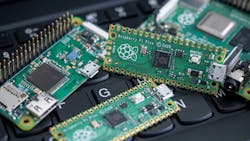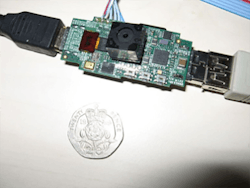This article is part of TechXchange: Raspberry Pi
What you’ll learn:
- History of Raspberry Pi.
- The latest Raspberry Pi innovations.
- Why design engineers choose Raspberry Pi.
Raspberry Pi is one of the best-selling, general-purpose computers in the world. When it was made available to the public in February 2012, the original sales target was just 10,000 units. On launch day, more than 100,000 units sold, and over the course of one year, that total would grow to 1 million.
In less than a decade since it debuted, 30 million iterations of the Raspberry Pi have been sold worldwide. So how did a minimalist single-board computer (SBC) built to inspire more young people to study computer science become such a staple of electronics design? Like any good story, it starts with humble beginnings.
Humble (Pi) Beginnings
Eben Upton knew computers were far too expensive for schools to purchase and saw first-hand the impact this had on the pipeline of college students interested in computer science. He noticed fewer and fewer students enrolling in related courses. Of those students who did enroll, they lacked the basic programming skills needed to succeed. He wanted to offer an affordable option that would help anyone and everyone have access to coding and computer science.
Upton’s second prototype, which was created in 2008, would be the one to give the single-board computer its well-known name. This machine, though not the powerful Pi most people recognize, had a blinking cursor that would boot into any Python code; thus, explaining the use of the word “Pi.”
As for “Raspberry,” Upton followed in the fruity steps of other computer and tech device companies that came before: Tangerine Computer Systems, Apricot Computers, Apple Computer, and a British company established in 1978, Acorn Computers, which is (fun fact) the fruit of an oak tree.
In 2009, the Raspberry Pi Foundation, which works to put the power of computing and digital making into the hands of people all over the world, was formed. The Foundation created the hardware, software, and educational outreach for what would eventually become the Raspberry Pi.
In 2011, the BBC showed a tiny prototype with an onboard camera and inline USB format (see figure). This USB dongle-style device never made it to market, but its spirit can certainly be felt in the Raspberry Pi Zero.
Raspberry Pi then moved over to a Broadcom system-on-chip (BCM2835). This Broadcom chipset would ultimately move to be used in the Raspberry Pi Model A, B, B+, the Compute Module, and Raspberry Pi Zero. The alpha boards began to feature a lot of the core Raspberry Pi features:
- HDMI out
- Analog video
- USB ports
- SD card
Between the end of 2011 and early 2012, Eben and his team finalized the late beta versions of the initial Raspberry Pi boards. The initial design included two USB 2.0 ports, 100-Mb/s Ethernet, and the now famous 26-pin GPIO header. The launch processor was a 700-MHz single-core processor and VideoCore IV GPU capable of hardware-accelerated 1080p video playback.
It was the Raspberry Pi 1 Model B that racked up 100,000 sales on its very first day after launching in February 2012. Part of the success of that very first Raspberry Pi came from its partnership with Newark. By reducing lead times, improving flexibility, and ensuring availability and reliability of component supplies, more than two million units sold within two years of mass production.
Finger in Every Pi
Raspberry Pi is now in the hands of thousands of teachers, students, makers, and professionals who continue to discover practical and unconventional uses for it.
The versatile SBC has acquired a laundry list of uses over the years, including an arcade game, a baby monitor, and a weather station. It can even power a music and light show that went viral and was shared as an extended promotional video on ABC’s “The Great Christmas Light Fight.”
Forums and chatrooms dedicated to all things Pi—new ways of using it, Questions & Answers, project highlights, and more—popped up all over the internet. One of those online communities, element14, celebrated Pi day this year with a roundup of their favorite Raspberry Pi projects. These grassroots inventions included everything from a speech-to-text light-up face mask to help the hard of hearing, to an International Space Station tracker for interstellar enthusiasts.
But Raspberry Pi doesn’t just live online or in the hands of tech and robotics hobbyists. In 2014, when the Compute Module was introduced, professional designers and makers were able to incorporate the SBC into their own custom systems and form factors. This flung the Raspberry Pi into a whole new marketplace.
In 2021, the company launched the $4 Raspberry Pi Pico, a low-cost microcontroller device that can be used to control and receive input from various electronic devices. The Pico does for microcontrollers what the original Raspberry Pi did for single-board computing.
Today, its products are embedded into our daily lives and can be found in smart-home devices, hospital ventilators, and display screens at airports, to name a few. SBCs also play an increasingly important role in industrial design. Over 50% of Raspberry Pi boards are now being used by industrial and embedded customers and original equipment manufacturers.
Design engineers choose the Raspberry Pi for the same reasons it was built for its original education audience: low cost, small form factor, immense processing power, ease of use, and compatibility with a wide range of accessories. The potential for Raspberry Pi applications is immense. It’s outstripped everyone’s expectations over the years and its popularity continues to soar. Uses for Raspberry Pi are destined to increase for years to come.
Read more articles like this at TechXchange: Raspberry Pi
About the Author
Dianne Kibbey
Dianne Kibbey joined Farnell's global business in 1999. Dianne now heads up the element14 online community for electronic design engineers. Since its inception in 2011, she has led on overall content, marketing, and engagement, driving year-on-year increases in participation and the community’s recognition as a global forum for engineers.
The element14 community has become a place for engineers to collaborate, learn about new technology, solve problems, and access leading products to complete their designs, and through its regular design challenges, a hub for innovation. In 2012, element14 was the winner of the Forrester Groundswell award for supporting B2B customers and Jive’s Customer award for engaging customers.
Dianne’s 20+ year career in technology and eCommerce gives her deep insight into how to engage a technical audience. Dianne also has a passion for encouraging education in the STEM (Science Technology, Engineering and Math) fields and has worked with key organizations such as Microsoft and Techgirlz to support the development of education for coding. Dianne holds a BS in Computer Science and an MBA in Entrepreneurial Business.

